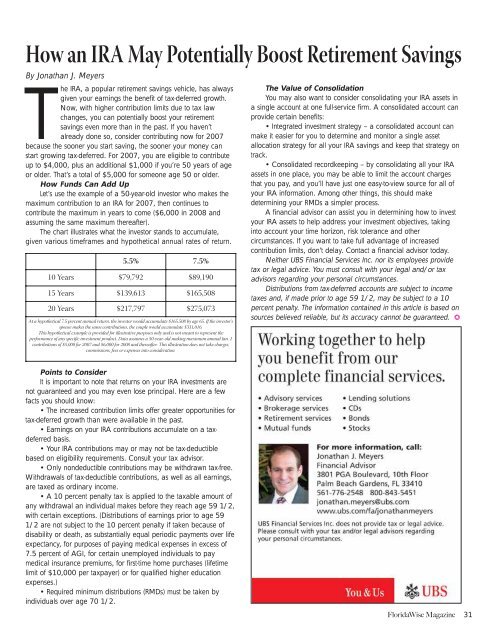inside: - Florida Wise
inside: - Florida Wise
inside: - Florida Wise
Create successful ePaper yourself
Turn your PDF publications into a flip-book with our unique Google optimized e-Paper software.
How an IRA May Potentially Boost Retirement Savings<br />
By Jonathan J. Meyers<br />
The IRA, a popular retirement savings vehicle, has always<br />
given your earnings the benefit of tax-deferred growth.<br />
Now, with higher contribution limits due to tax law<br />
changes, you can potentially boost your retirement<br />
savings even more than in the past. If you haven’t<br />
already done so, consider contributing now for 2007<br />
because the sooner you start saving, the sooner your money can<br />
start growing tax-deferred. For 2007, you are eligible to contribute<br />
up to $4,000, plus an additional $1,000 if you’re 50 years of age<br />
or older. That’s a total of $5,000 for someone age 50 or older.<br />
How Funds Can Add Up<br />
Let’s use the example of a 50-year-old investor who makes the<br />
maximum contribution to an IRA for 2007, then continues to<br />
contribute the maximum in years to come ($6,000 in 2008 and<br />
assuming the same maximum thereafter).<br />
The chart illustrates what the investor stands to accumulate,<br />
given various timeframes and hypothetical annual rates of return.<br />
5.5% 7.5%<br />
10 Years $79,792 $89,190<br />
15 Years $139,613 $165,508<br />
20 Years $217,797 $275,073<br />
At a hypothetical 7.5 percent annual return, the investor would accumulate $165,508 by age 65. If the investor’s<br />
spouse makes the same contributions, the couple would accumulate $331,016.<br />
This hypothetical example is provided for illustrative purposes only and is not meant to represent the<br />
performance of any specific investment product. Data assumes a 50-year-old making maximum annual Jan. 1<br />
contributions of $5,000 for 2007 and $6,000 for 2008 and thereafter. This illustration does not take charges,<br />
commissions, fees or expenses into consideration.<br />
The Value of Consolidation<br />
You may also want to consider consolidating your IRA assets in<br />
a single account at one full-service firm. A consolidated account can<br />
provide certain benefits:<br />
• Integrated investment strategy – a consolidated account can<br />
make it easier for you to determine and monitor a single asset<br />
allocation strategy for all your IRA savings and keep that strategy on<br />
track.<br />
• Consolidated recordkeeping – by consolidating all your IRA<br />
assets in one place, you may be able to limit the account charges<br />
that you pay, and you’ll have just one easy-to-view source for all of<br />
your IRA information. Among other things, this should make<br />
determining your RMDs a simpler process.<br />
A financial advisor can assist you in determining how to invest<br />
your IRA assets to help address your investment objectives, taking<br />
into account your time horizon, risk tolerance and other<br />
circumstances. If you want to take full advantage of increased<br />
contribution limits, don’t delay. Contact a financial advisor today.<br />
Neither UBS Financial Services Inc. nor its employees provide<br />
tax or legal advice. You must consult with your legal and/or tax<br />
advisors regarding your personal circumstances.<br />
Distributions from tax-deferred accounts are subject to income<br />
taxes and, if made prior to age 59 1/2, may be subject to a 10<br />
percent penalty. The information contained in this article is based on<br />
sources believed reliable, but its accuracy cannot be guaranteed. ❂<br />
Points to Consider<br />
It is important to note that returns on your IRA investments are<br />
not guaranteed and you may even lose principal. Here are a few<br />
facts you should know:<br />
• The increased contribution limits offer greater opportunities for<br />
tax-deferred growth than were available in the past.<br />
• Earnings on your IRA contributions accumulate on a taxdeferred<br />
basis.<br />
• Your IRA contributions may or may not be tax-deductible<br />
based on eligibility requirements. Consult your tax advisor.<br />
• Only nondeductible contributions may be withdrawn tax-free.<br />
Withdrawals of tax-deductible contributions, as well as all earnings,<br />
are taxed as ordinary income.<br />
• A 10 percent penalty tax is applied to the taxable amount of<br />
any withdrawal an individual makes before they reach age 59 1/2,<br />
with certain exceptions. (Distributions of earnings prior to age 59<br />
1/2 are not subject to the 10 percent penalty if taken because of<br />
disability or death, as substantially equal periodic payments over life<br />
expectancy, for purposes of paying medical expenses in excess of<br />
7.5 percent of AGI, for certain unemployed individuals to pay<br />
medical insurance premiums, for first-time home purchases (lifetime<br />
limit of $10,000 per taxpayer) or for qualified higher education<br />
expenses.)<br />
• Required minimum distributions (RMDs) must be taken by<br />
individuals over age 70 1/2.<br />
<strong>Florida</strong><strong>Wise</strong> Magazine 31





![FloridaWise Magazine Media Kit [PDF]](https://img.yumpu.com/45090301/1/190x245/floridawise-magazine-media-kit-pdf.jpg?quality=85)


